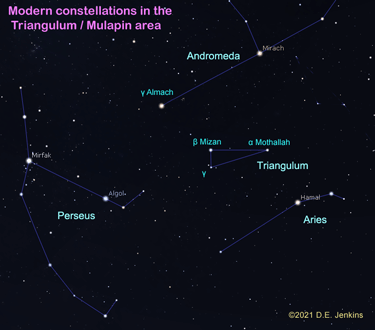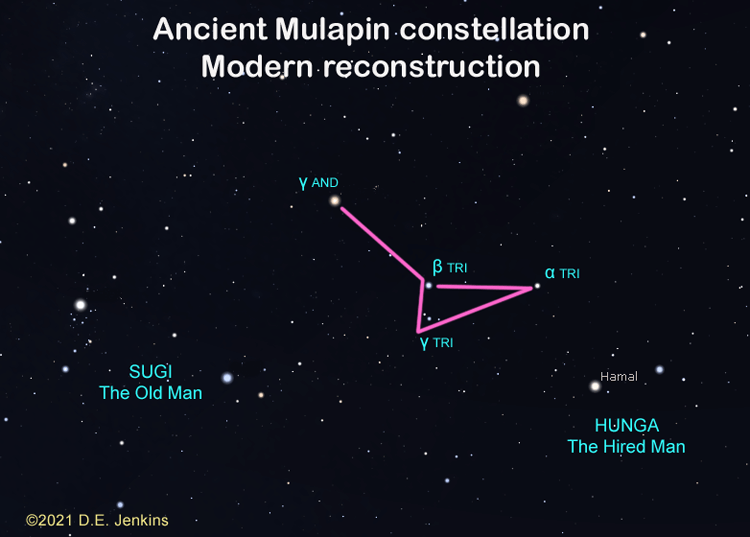
November 2021 - Vol. 25, No. 11
This Month's Night Sky - NOTE: The next paragraph describes the sky as it appears at 10 pm EST (11 pm EDT) near mid- month. The sky also looks this way at 11 pm EST (midnight EDT) during the beginning of the month and at 9 pm EST (10 pm EDT) by month's end.
If you are blest with a dark observing site, the Orion arm of the Milky Way(the galaxy we inhabit) arches overhead from horizon to horizon. Embedded are the stars of constellations Cassiopeia, denoted by its familiar "W" or Sigma asterism, and Perseus. The Summer Triangle finally disappears early in the W. Although there are no bright stars due S., red Aldebaran and the tiny dipper asterism of the Pleiades’s, a famous open star cluster (Taurus), as well as yellow Capella (Auriga) glow in the SE. Later follows the twins, Castor and Pollux (Gemini), and the hour-glass asterism of constellation Orion with fuzzy M42 (Great Orion Nebula) just below its three "belt" stars, that heralds the coming of winter.
MERCURY is briefly visible as the month opens and a daylight occultation of Mercury by the Moon occurs on the 3rd, and superior conjunction on the 29th. VENUS still favors the southern hemisphere in the evening sky. MARS is too close to the Sun but should be emerging from conjunction by Month's end. JUPITER shines brightly in Capricornus. SATURN sets before midnight still in Capricornus. URANUS at opposition on November 5, among the stars of Aries. NEPTUNE is in Aquarius, visible in the evening sky.
Review how to determine Angular Measurement.
Calendar of Events
NOTE: For those observers not in the ET zone, convert the calendar times to your zone's time by subtracting one hour for CT, two for MT and three for PT. Don't forget to adjust for Daylight Savings Time when necessary by subtracting one hour from your planisphere's time. Dawn and dusk times must also be corrected. See your local newspaper, TV news, or cable TV's Weather Channel for sunrise and sunset times or check with the U.S. Naval observatory. Unfortunately some of these events may occur during daylight hours in your area.
| DATE | EVENT |
| 03 | Mercury 1.2 deg. S. of Moon, occultation from Canada, northeastern USA, and Bermuda during daylight hours. |
| 05 |
Moon at perigee. Uranus at opposition. S. Taurid meteor peak. The hourly rate of this shower is about 10 per hour at peak. This year the moon is 1 days past new. |
| 07 | Daylight savings time (DST) ends for affected areas. |
| 08 | Venus 1.1 deg. S. of Moon, occultation from NE Mongolia, NE China, SE Russia, Japan, and W Aleutian islands. |
| 10 | Saturn 4 deg. N. of Moon. Mercury in conjunction with Mars, too close to the Sun to be easily observed. |
| 11 | Jupiter 4 deg. N. of Moon. |
| 12 | N. Taurid meteor peak expect to reach 15 per hour at peak, this year the Moon is past first quarter and may interfere with observation of meteors. |
| 17 | Leonids meteor shower produces up to 20 meteors per hour. |
| 18 | Uranus 1.5 deg. N of Moon. |
| 19 | Partial lunar eclipse. |
| 21 | Moon at apogee. |
| 22 |
Moon 1.8 deg. N of M35. Mercury at descending node. |
| 27 | Ceres asteroid at opposition. |
| 29 | Mercury in superior conjunction. |
Lunar Almanac for November 2021
| Phases of the Moon | Phase and Date(s) | Best viewed before local midnight |
 |
New 04 |
Deep Space Objects |
 |
1st. Qtr 11 |
Planets & Moon |
 |
Full 19 |
Moon |
 |
Last Qtr 27 |
Deep Space & Planets |
Topic of the month: Mul Apin

The stars of the Plow constellation come from the modern constellation, Triangulum, whose brightest star is called Mizan at 3.0 mag. It is the Beta star rather than the fainter Alpha star called Mothallah (3.4 mag) or Caput Trianguli. The triangle is completed by Gamma Trianguli, a star with no common proper name. Almach completes the ancient constellation.
The rising of Mulapin with the Sun helped the ancient Mesopotamian astronomers to identify the exact time of the Spring equinox. Astronomers and calendar keepers are sometimes called priests because they were employed by the temple. But they were not priests, they were dedicated astronomers. It is true that they watched the stars to read the "signs" in the sky. This is because they believed the Gods were sending them messages. The meanings of these signs were kept in texts that modern scholars call "Enuma Anu Enlil". The astrology of the ancient Mesopotamians was not astrology as it is known today - - that is derived from ancient Greek astrologers. The fact that Mesopotamian astronomers worked for the temple and used a text to interpret planetary motions does not diminish the quality of their science. They knew the sky better than astronomers of today and they lacked the tools of modern times. Ancient Mesopotamians provided the base for our modern astronomy through an observing program that they conducted for about 800 years.
Because observing conditions in Mesopotamia were not always the best, the ancient astronomers devised a method of tracking the location of stars they were interested in using other stars that they could see. These stars were called "zigpu"stars. Their observational methods allowed fairly precise celestial measurements. This process was assisted by their lunar calendar keeping system that is beyond the scope of this article. Zigpu stars helped them decide that Mulapin was about to emerge in the early morning sky. Although they followed a lunar calendar, they understood the important positions of the Earth in relationship to the Sun.
In order to understand the constellation better, we've reconstructed the ancient constellation of Mulapin in the image below. Two other figures are noted, one is Sugi or the Old Man seen by the ancient astronomers. This is today's constellation of Perseus, a Greek hero. Perhaps the ancients saw Perseus as a bent over old man. As for the other character noted among the stars of Aries, the hired man or Hunga, this constellation represented the workers who were hired to help clean up the irrigation ditches or till the ground for the new harvest. They would be hired around the time of the year the constellation was rising in the early morning hours. Maybe the old man hired the worker to use the plow in the field. In any case, they probably incorporated some of the stars of the constellation of Cetus that are also near the ecliptic.

To find Mulapin in the night sky you need a fairly dark sky as the stars are 3rd magnitude or fainter. At this time of year, it rises long before the Sun sets. Look for a triangle of stars near the Great Square of Pegasus. It is between the constellations of Aries and Pegasus. Triangulum will transit the meridian (for northern observers) around midnight.
The ancient astronomers in Mesopotamia had a rich lore surrounding the constellations in the sky. The next time you encounter the Mul.Apin, remember it is only called that because that is the first word on the clay tablets where the ancient scribes recorded their astronomical knowledge. MulApin itself is a small constellation that helped humans keep up with solar time, a Star Plow.
--See You Under the Stars!
Astra for Astra's Almanac
This installment of "What's Up?" is ©2021 by Dawn Jenkins for Astra's Stargate. View Ron Leeseburg's Farewell Issue for information on where to find information such as is presented in this almanac.